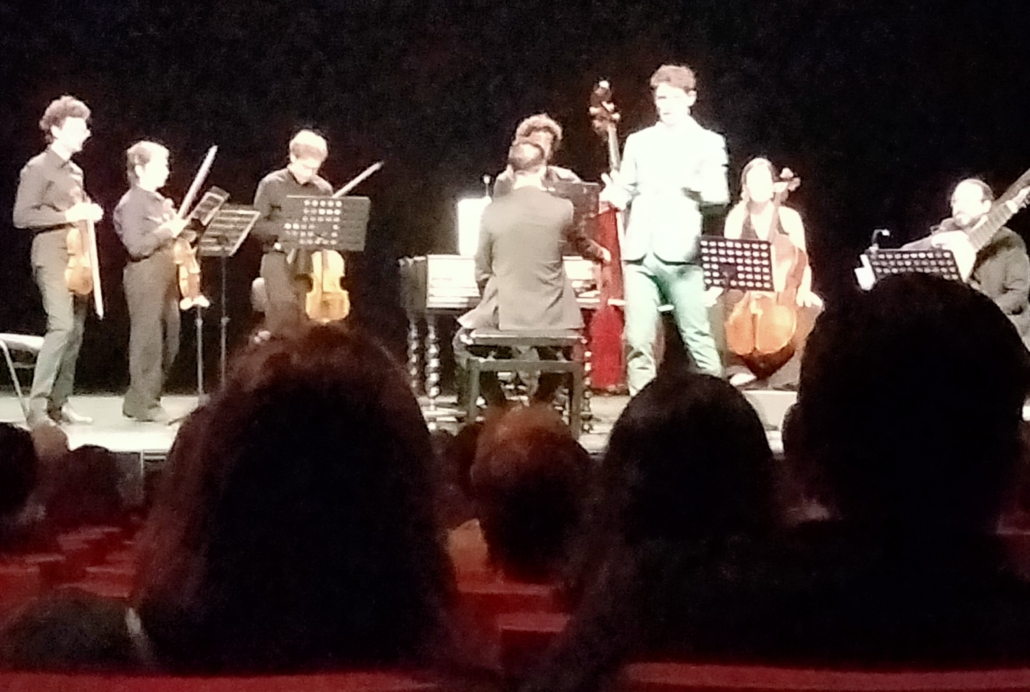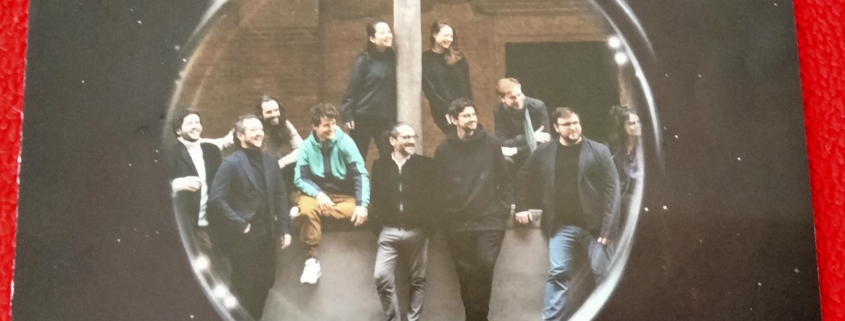A VOICE HELD IN HIGH REGARD
A VOICE HELD IN HIGH REGARD
JAKUB J. ORLINSKI:
& il pomo d’oro – Francis Corti Extraordinary Concert
El Salinero Theatre Arrecife Lanzarote, February
part of the 40th anniversary tour of FIMC
review by Norman Warwick

Jakub J Orlinski (shown left in green suit) became a master of falsetto almost by chance, due to a draw in a choir in which he sang as a teenager. Today, the Polish vocalist is a leading countertenor who triumphs beyond the stage. His recordings and his parallel actions offstage make him a personality whose influence crosses borders.
His media appearances, his participation in first-rate musical events, the awards he has won and much more make going to see Orlinski in concert a real event, whether in recital format, in operas or in concert with groups. And, on many occasions, the public is lucky enough to see a breakdancing exhibition – his other great passion – by the artist outside the venue.
Despite such glowing references, we had not previously heard of Jakub and our awareness of countertenors in general was slim to nil. I think we were concerned it might be an acquired taste and we weren´t sure what would happen here, but we had ordered our tickets to see and hear Orlinski at 40 FIMC.
He brought to the stage a baroque repertoire, together with the ensemble il pomo d’oro, Italian musicians with whom he regularly works, under the direction of Francesco Corti. The piece was called FACCE D’AMORE, which they recorded together and have performed on many stages around the planet.
This was an example of many interesting placement of soloists and ensembles performing across the rest of this years 40th Anniversary Festival Of International Classical Music On The Canary Islands performing over the six weeks or so in January and February.
You can imagine that a tour containing several orchestras and ensembles and their musicians and their musical instruments, travelling by air or sea from island to island could be a logistical nightmare !
We have to be flexible and eclectic to be an FIMC follower as there is such a diversity of classical musical innovations, but the trick is to be open-minded and receptive to what is presented.

On this occasion six musicians stepped on to the stage with two violins, a viola, upright bass and violin-cello, a keyboard and an instrument that looked like a modern update of a lute, or even a sitar with a long think neck. It was actually called a Tiorba aka the theorbo which is a plucked string instrument of the lute family, with an extended neck that houses the second pegbox. Like a lute, a theorbo has a curved-back sound box with a flat top, typically with one or three sound holes decorated with rosettes. As with the lute, the player plucks or strums the strings with the right hand while “fretting” (pressing down) the strings with the left hand.

The theorbo (left) is related to the liuto attiorbato, the French théorbe des pièces, the archlute, the German baroque lute, and the angélique (or angelica). A theorbo differs from a regular lute in its so-called re-entrant tuning in which the first two strings are tuned an octave lower. The theorbo was used during the Baroque music era (1600–1750) to play basso continuo accompaniment parts (as part of the basso continuo group, which often included harpsichord, pipe organ and bass instruments), and also as a solo instrument. It has a range similar to that of the cello.
The Italian theorbo first arrived in England at the beginning of the seventeenth century, but an alternate design based on the English two-headed lute, designed by Jaques Gaultier, soon became more popular. English theorbos were generally tuned in G and double strung throughout, with only the first course in re-entrant tuning. Theorbos tuned in G were much better suited to flat keys, and so many English songs or concert pieces that involved theorbo were written in flat keys that would be very difficult to play on a theorbo in A. By the eighteenth century, the theorbo had fallen out of fashion in England due to its large size and low pitch. It was replaced by the archlute.
We might not have known much about Jakub, but the mighty welcome given to him when he stepped out a few moments later to join his musicians, it sounded like everybody else in the theatre knew him and loved him, so raprturous was the applause.

Dressed in a Kermit-Green suit and open necked shirt it immediately became apparent that Jakub is an engaging character. He made jokes, was really appreciative of the talents of the players and spoke English when introducing the work tonight as a collection of love stories with all the joy and betrayal and heartbreak that love can bring.
His body and head movements would perhaps have signalled, had we not recently learned about it, his love of breakdancing.
After a few bars played by the ensemble, Jakub joined in singing.
My God the voice seemed achingly, but effortlessly, high, and to our British likings for the rough and growled notes of Rod Stewart, for instance, it at first sounded very strange indeed. At first I feared that my initial, somewhat childish recollections of Tiny Tim as he took a Tiptoe Through The Tulips and up the British charts in the nineteen sixties. What Jakub was presenting though was the result of years of training and dedication and when he hit the climactic sustained notes it was magnificent,. That he was singing on top of this wonderfully played classical music was incredible, and there were several shouts of bravo from audience members throughout the performance.
The concert had some interesting dynamics that kept us thoroughly attentive and the difference in the sound when the players switched to guitar for a couple of recitals was very noticeable. The applause at the end of the show demanded a couple of well deserved encores and I left the theatre reminding myself that we should never be dismissive, nor assume that any non-mainstream genre is a novelty act.
Would I pay to hear this kind of music again?
Abso-blooming-lutely !
There sounded to have been a generous German contingent to the audience, with the most obviously heard language being Spanish.
For Dee and I and our two reporters with no names this was a real treat, and new-to- me musical art form that we shall certainly follow more closely from now on.




Leave a Reply
Want to join the discussion?Feel free to contribute!